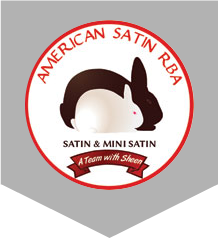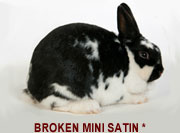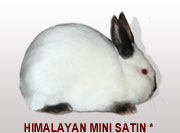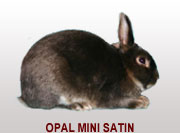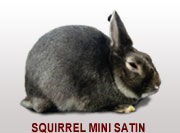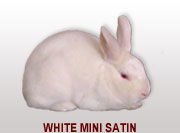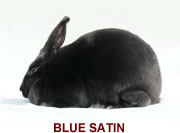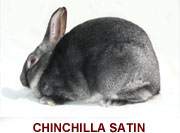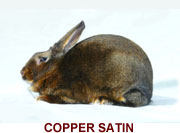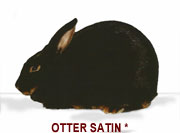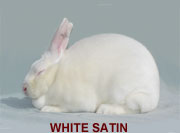A HISTORY
Satins and Mini Satins, affectionately known as “Team Sheen” are arguably two of the most beautiful breeds to be found in “rabbitdom”. Their unique fur structure gives both breeds an eye-catching sheen reminiscent of fine satin. Satins – the larger of the two breeds first appeared as a mutation in a litter of Havanas owned by Walter Huey of Pendelton, Indiana in 1934. Before this mutation appeared, the rabbit world had seen nothing like it! Mr. Huey, sent some of these animals to Harvard University, where geneticists determined that this new mutation was a simple recessive gene for the shine and texture of the coat due to transparency of the cuticle of the hair shaft. When Mr. Huey showed these Havanas with the brilliant sheen against the normal Havanas, a storm of protest ensued, therefore the rabbits were given the name of ‘Satin Havanas’, and initially were recognized by the National Havana Club. In 1942 the American Federation of Havana Breeders voted to sponsor the Satin breed in the various colors. By 1939, Satin colors could be found in: Brown, Black, Blue, White, and Orange. In 1946, another club was organized for the breed – the American Satin Rabbit Breeders Association with two colors recognized – Ruby-eyed White and Chinchillas. Oddly there were two different sets of points for the two varieties, as the emphasis on type was placed on the Whites, which were developed from New Zealand Whites, and on color for the Chinchilla variety. In 1956, eight varieties were recognized for the breed. Siamese Satins, were accepted in 1965 and in this same year one standard set of points were written for all the varieties. Broken Satins were finally recognized in 1985, which gave a huge boost to the breed and Otter Satins, were recognized in 2001. In 2022, Lilac was added along with the Blue, Chocolate, and Lilac versions of Himalayan (formerly Californian) and Siamese, bringing us to the 12 accepted Satin varieties we have today.
Mini Satins are also an American creation and like the great melting pot that is this country, several breeds had a role in its creation. The first attempt at creating a compact satinized breed occurred in 1970 by Mrs. Ariel Hayes, of Troy, Michigan. Ms. Hayes dubbed her new breed the “Satinette” which sprang from crosses between Polish and Satins. She worked on the Satinettes for 12 years before abandoning the COD. In the late 1980’s, B. Pettit (a well-known Netherland Dwarf breeder), began satinizing Netherland Dwarfs. Later in 1990 a Michigan man was located that was breeding a Satinette, who said that he started in 1983 (possibly but not confirmed to be stock from the earlier Hayes COD). An agreement was made between this Michigan breeder and Sue and Verle Castle to work together and present the Satinette under the Castles’ name and nine colors were chosen for the first presentation. The Standards Committee did not care for the colors chosen for the development of the breed and assisted the parties with color selection and re-writing the standard. Colors now to be worked on were: Copper, Red, Ruby-Eyed White, Sable and Siamese. Unfortunately this ultimately created a rift in the original partnership between the Castles and the Michigan breeder and in January of 1994 the COD for the Satinette was dropped yet again. In February of 1994 Jim Krahulec, purchased all of the Castles’ Satinettes, and began to develop the breed, but went to a larger version, as he felt that they were too much like a satin-coated Netherland Dwarf. For the first time the name, “Mini Satin” was given to this new incarnation of the breed. Mr. Krahulec, obtained three underweight Satin bucks and began to breed this with the Satinette does in the spring of 1994. By autumn of 1994 the normal Satins were disposed of in the breeding program, and the youngsters from those crosses were further mated to Mini Satin bucks. Jim Krahulec, submitted a proposed standard and five varieties: Black, Chocolate, Copper, Himalayan, and Red to the ARBA’s Standard Committee on June 30, 1995, and a Certificate of Development for the Mini Satin was granted in September of the same year. A great effort was made to develope the Mini Satin under Jim Krahulec’s COD, unfortunatey the breed ultimately failed to pass it’s final attempt in Louisville, Kentucky in 1999.
J. Leo Collins, of Salem, Ohio, took up the torch and was granted a Certificate of Development for the Mini Satins, which were presented for the first time at the Wichita, Kansas ARBA Convention and Show in 2003, where two varieties; Ruby-Eyed White and Red, were accepted by the committee for a first showing, therefore completing one leg of their journey in becoming a recognized breed in America. In 2005 the Whites were accepted in Indiana and became the ARBA’s 47th new breed in February of 2006. Mini Satins have come a LONG way since its first rocky beginnings. We now have an amazing 18 varieties* (including the Broken and Otter groups), and the two newsest additions – Lilac and Lynx.
Below are representative photos of each of the 14 Satin varieties and 18 Mini Satin varieties. Please refer to the latest edition of the ASRBA Official Guidebook – available to all ASRBA members, for detailed articles on each variety. Not a member? Now is the perfect opportunity to join the ASRBA!
MINI SATINS
* Note: Broken, Himalayan, Otter, Siamese, Silver Marten, and Tortoise Mini Satins are each shown as a GROUP.
Broken Mini Satins includes all recognized color varieties in conjunction with white. All varieties are judged together.
Himalayan Mini Satins (a pointed group – white with colored markings on the nose, ears, feet, tail, and legs), include 4 varieties: Black, Blue, Chocolate, and Lilac. Blacks are a dark sepia – nearly black. Blues are a rich dark blue. Chocolates are a rich dark brown. Lilacs are a uniform, medium dove gray, with pink tint on the surface. The eyes on all varieties are pink. All varieties are judged together.
Otter Mini Satins include 4 varieties: Black, Blue, Chocolate, and Lilac. The self color on Lilacs is a dove-gray with a pinkish tint. Pattern on Blacks and Chocolates to be creamy white on belly, underside of chin and tail. Belly is divided from body color by a distinct border of orange. Nostrils and Triangle to be orange or tan. Eye circles and inside of ears are creamy white highlighted by orange. Chest is an even mixture of orange and the body color, merging into the body color. Pattern on Blues and Lilacs to be creamy white on belly, underside of chin and tail. Belly is divided from body color by a distinct border of fawn. Nostrils and Triangle to be fawn. Eye circles and inside of ears are creamy white highlighted by fawn. Chest is an even mixture of fawn and the body color, merging into the body color. Eye color of Blacks and Blues are brown and blue-gray in Blues and Lilacs. All varieties are judged together.
Siamese Mini Satins include 4 varieties: Siamese, Blue, Chocolate, and Lilac. Siamese are a dark sepia brown on ears, head, feet, belly, and tail that shades to a medium brown on the body. The undercolor is an off white. Blues are a dark blue on the extremities shading to a medium blue on the body. Chocolates are a dark chocolate color on extremities shading to a medium chocolate on the body. Lilacs are a dark dove gray on the extremities – shading to a medium dove gray on the body. Eye color of Siamese and Chocolates is brown. Eye color on Blues and Lilacs is blue-gray. All varieties are judged together.
Silver Marten Mini Satins include 4 varieties: Black, Blue, Chocolate, and Lilac. Surface color on Lilacs is a dove gray with a pinkish tint. The surface color on Blacks, Blues, and Chocolates is to conform to their respective self varieties. nostrils, eye circles, jowels, inside of ears triangle, collar, back of fore feet, inside of hind feet and legs, belly and underside of the tail are silver-white.Silver-white guard hards are distributed prominently on the chest, sides, and lower hindquarters. Eye color of Blacks and Chocolates are brown and blue-gray in Blues and Lilacs. All varieties are judged together.
Tortoise Mini Satins include 4 varieties: Black, Blue, Chocolate, and Lilac. Blacks and Chocolates are a clean orange on the saddle that blends to darker shading over the lower rump and hindquarters. Blues and Lilacs are a clean fawn on the saddle that blends to a darker shading over the lower rump and hindquarters. Top of the tail on all varieties should match the body color. Underside of the tail is to match the shadings of its respective variety as much as possible. Shading on the head and whisker bed is the darkest, blending into a lighter shade on the jaw line, darkening again at the ear base, blending up to match the body color. Eye color of Blacks and Chocolates are brown and blue-gray in Blues and Lilacs. All varieties are judged together.
SATINS
* Note: Broken and Otter Satins are each shown as a GROUP.
Broken Satins includes all recognized color varieties in conjunction with white. All varieties are judged together.
Otter Satins include 4 varieties: Black, Blue, Chocolate, and Lilac. The self color on Lilacs is a dove-gray with a pinkish tint. Pattern on Blacks and Chocolates to be creamy white on belly, underside of chin and tail. Belly is divided from body color by a distinct border of orange. Nostrils and Triangle to be orange or tan. Eye circles and inside of ears are creamy white highlighted by orange. Chest is an even mixture of orange and the body color, merging into the body color. Pattern on Blues and Lilacs to be creamy white on belly, underside of chin and tail. Belly is divided from body color by a distinct border of fawn. Nostrils and Triangle to be fawn. Eye circles and inside of ears are creamy white highlighted by fawn. Chest is an even mixture of fawn and the body color, merging into the body color. Eye color of Blacks and Blues are brown and blue-gray in Blues and Lilacs. All varieties are judged together.
NEW VARIETY STANDARDS & CODs
New Variety Standards
Current CODs
Smoke Pearl Mini Satin
Blue Eyed White Mini Satin
